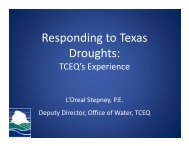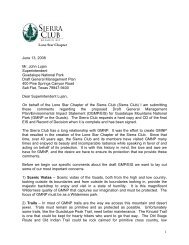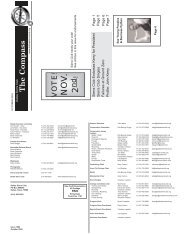Fall 2002 - Lone Star Chapter, Sierra Club
Fall 2002 - Lone Star Chapter, Sierra Club
Fall 2002 - Lone Star Chapter, Sierra Club
Create successful ePaper yourself
Turn your PDF publications into a flip-book with our unique Google optimized e-Paper software.
<strong>Lone</strong> <strong>Star</strong> <strong>Sierra</strong>n <strong>Fall</strong> <strong>2002</strong> 11<br />
Your Environment<br />
Conservation of Texas Land and Water<br />
Resources Highlighted at <strong>Chapter</strong><br />
Conference<br />
Conference Marks First Anniversary of Wide Open Spaces Campaign<br />
The <strong>Lone</strong> <strong>Star</strong> <strong>Chapter</strong> of the <strong>Sierra</strong> <strong>Club</strong> celebrated the first anniversary of the Wide Open<br />
Spaces Campaign with a well-attended sixth annual <strong>Chapter</strong> Conservation Conference at the<br />
Armand Bayou Nature Center in Houston on July 20. This year’s conference, which drew in<br />
excess of 100 people, focused on the need to increase parkland and to protect open space and<br />
wildlife habitat in a variety of ways statewide and in East Texas.<br />
Keynote Presentation –<br />
Texas at the Crossroads<br />
The keynote speaker, Texas<br />
Tech University President Dr.<br />
David Schmidly, shared historical<br />
and current information over the<br />
past century using a time-lapse<br />
style presentation to<br />
document the changes<br />
in Texas population,<br />
landscape and wildlife<br />
diversity. Dr. Schmidly’s<br />
presentation, Texas at<br />
the Crossroads: A Historical<br />
Perspective on the<br />
Biological Diversity of<br />
Texas, emphasized the<br />
present critical stage of<br />
the State’s environmental<br />
movement. Dr.<br />
Schmidly compared<br />
primary data from a<br />
biological survey conducted<br />
a century ago by<br />
Vernon Bailey with<br />
current data from The<br />
Texas Parks and Wildlife<br />
for the 21 st Century report<br />
prepared by Texas Tech for Texas<br />
Parks and Wildlife Department<br />
(TPWD) in 2001.<br />
Based on this comparison Dr.<br />
Schmidly identified the most<br />
important threats facing biological<br />
diversity in Texas. The threats<br />
include (1) urban sprawl (the<br />
migration to and expansion of<br />
urban areas), (2) lack of ethnic<br />
diversity in the environmental<br />
movement, (3) land fragmentation,<br />
(4) non-native plants and animals,<br />
(5) loss of valuable terrains (i.e.,<br />
wetlands, hardwood bottom forests,<br />
prairies) and (6) an increase in<br />
numbers of rare, endangered, and<br />
extinct animals in Texas.<br />
Dr. Schmidly provided some<br />
guidance on how to address these<br />
Brian Sybert, Natural Resources Director for the <strong>Lone</strong> <strong>Star</strong><br />
<strong>Chapter</strong> and director of this year’s conservation conference,talks<br />
about the Wide Open Spaces Campaign.<br />
threats through what he termed<br />
“The Ten Commandments of<br />
Conservation.” These include<br />
finding a common ground, developing<br />
an adequate information base,<br />
recognizing the changing nature<br />
of the clientele, avoiding single<br />
species approaches to conservation,<br />
and focusing on sustainable<br />
resources and ecosytem management.<br />
The other “commandments”<br />
include strengthening<br />
scientific research, making<br />
conservation education a priority<br />
for the public, increasing participation<br />
of private landowners,<br />
expanding protected area acquisition<br />
and management, and promoting<br />
regionally-based conservation<br />
planning.<br />
State Land and<br />
Water Plan<br />
Dr. Schmidly’s presentation<br />
was followed by an<br />
overview of the Texas<br />
Parks & Wildlife<br />
Department’s statewide<br />
Land and Water Conservation<br />
and Recreation Plan<br />
by Jeff Francell and Emily<br />
Armitano. Francell is the<br />
Land Acquisition Director<br />
for TPWD and Armitano is<br />
a Policy Analyst for TPWD.<br />
Francell discussed how<br />
this plan was different<br />
from the Texas Tech study<br />
presented by Dr. Schmidly<br />
and the recommendations of the<br />
Governor Bush’s Task Force on<br />
Conservation. According to<br />
Francell this plan is different<br />
because it is actually being created<br />
by TPWD staff and will be<br />
adopted by the Texas Parks and<br />
Wildlife Commission, the governing<br />
body for TPWD.<br />
The plan was mandated by the<br />
Continued next page







